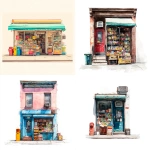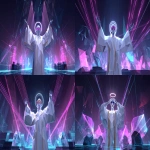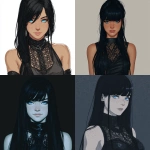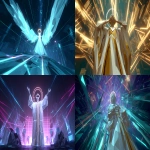Explore the Best AI Image Gallery

AI Imagery in Marketing: Redefining Creativity and Engagement
As the digital landscape continues to evolve, artificial intelligence (AI) has become a game changer in various industries, particularly in marketing. The ability to generate images using AI technologies has not only transformed how brands communicate visually but has also redefined the creative process. This blog post explores the impact of AI images on the creative industry, potential applications in marketing, ethical concerns, and future trends that could shape the future of visual storytelling.
The Impact of AI on the Creative Industry
Traditionally, the creative industry relied heavily on human talent for generating visual content. However, with advancements in AI, including deep learning and neural networks, this norm is shifting. AI tools can analyze vast datasets to create images that resonate with specific target audiences, thus allowing marketers to tailor their campaigns more efficiently.
One notable advantage is the speed at which AI can generate images. In contrast to human creators, AI can deliver high-quality visuals in a fraction of the time. This efficiency is particularly beneficial for brands needing content across multiple platforms and formats. Additionally, AI can facilitate continuous creativity by providing diverse visual styles and concepts based on various input parameters, expanding the horizons of what is possible in an advertising campaign.
Potential Uses of AI Images in Marketing
The application of AI-generated images in marketing can be seen across multiple dimensions:
- Product Visualization: Brands can utilize AI to create realistic images of products, particularly helpful for e-commerce. Customers can see the product in various settings, colors, and use cases without the need for extensive photoshoots.
- Personalized Marketing: AI can generate customized visuals for different segments of an audience, enhancing engagement. For example, a brand might create images featuring their product being used by individuals from various demographics.
- Content Creation: AI-generated visuals can be integrated into blogs, social media posts, and advertisements, maintaining a consistent visual language that reflects the brand effectively.
- Interactive Advertising: AI can create dynamic images that change based on user interaction, providing a unique and engaging experience that captures attention more effectively than static ads.
Ethical Considerations in AI-Generated Imagery
While the benefits of AI in marketing are evident, several ethical considerations must be addressed. The use of AI-generated images raises questions around authenticity and trust. As consumers become more discerning about the content they engage with, they may question whether images portraying products or services are genuine or fabricated.
Moreover, issues of copyright and ownership come into play. If an AI model generates an image, who owns the rights to that creation? This question remains largely unresolved as the legal frameworks struggle to keep pace with technological advancements.
Additionally, there's the potential for AI to perpetuate stereotypes if not carefully monitored. For instance, if AI algorithms are trained on biased data, it could result in imagery that reinforces societal norms or excludes certain demographics.
Future Trends in AI-Generated Imagery
Looking ahead, the integration of AI-generated images in marketing is poised for growth. Several trends are likely to shape this landscape:
- Increased Customization: AI algorithms will continue to evolve, empowering marketers to create highly personalized images that speak directly to individual consumer preferences.
- Real-Time Image Generation: As technology advances, the ability to produce images in real-time—based on user data and preferences—will become a key feature of many marketing campaigns.
- Sustainability Practices: Brands will increasingly use AI to minimize waste associated with traditional photography. AI images could reduce the need for physical production, leading to more sustainable practices.
- Integration with Augmented Reality (AR): The combination of AI-generated images and AR could provide immersive brand experiences that allow consumers to visualize products in their own environments.
Conclusion
AI-generated imagery is undeniably transforming the marketing landscape, and ongoing advancements in technology will only enhance its influence. While challenges around ethics and authenticity persist, the potential for creativity and engagement in marketing is vast. By navigating these challenges thoughtfully, brands can fully leverage AI to captivate their audiences and create lasting impressions.

](https://images.ai-img.art/thumbnails/150/058e808da703f55c4c6ff9009cfceb51153628ffc94cb42ddb9627ece60c5b3c.webp)
](https://images.ai-img.art/thumbnails/150/48bc6595bd726455bbeb1f2fef65efdd36a6264de2d9e253f6c5f9fd00dbbd21.webp)

](https://images.ai-img.art/thumbnails/150/05654f70ed91bfff26b57ce7abcba9e59fdcb86339c5db1e44e4cf6451b028b0.webp)








](https://images.ai-img.art/thumbnails/150/f88682ac7749bbd2e80ef281a2f196215a7d5515866a6925e1ee15ccea1b2e8e.webp)





](https://images.ai-img.art/thumbnails/150/5fe4e4a0b755f7ee536875c4418d1307af56f0b399cc9459f01ca7b2307f906c.webp)
](https://images.ai-img.art/thumbnails/150/d09aea54eca5de3b78e08fd836012ff6a23d17835a2473c901b4859073a93cf2.webp)

](https://images.ai-img.art/thumbnails/150/886c07228472ed209e01fcf32d6d4d1d2d7577280258b4c2a2c7db7ec749b95c.webp)

](https://images.ai-img.art/thumbnails/150/02120d31d5771fadbd25ea482d4fea0a00db4203579724231b752a52fe0e7e4c.webp)



](https://images.ai-img.art/thumbnails/150/db8c0ceb5fc7105e6e975a02df61497f198371c8de6a53c7867f346b1708c13a.webp)








](https://images.ai-img.art/thumbnails/150/252bd2057e5882209a393dc6a7b2f5b238c67f12dc0401608867543ab2acf39b.webp)




](https://images.ai-img.art/thumbnails/150/b23568689bdc550e1f653d225620666e319e1ef840eb35121c2ff61ea639a6f6.webp)




](https://images.ai-img.art/thumbnails/150/0eba954f29355e6fd5353c2b3fcbedd909f8a5e462d0a5982880af5bb19a12ad.webp)

](https://images.ai-img.art/thumbnails/150/072fd597f9213821953f6a8e2e7ac3e3569f1c69444b6b2502bf31525fc98576.webp)